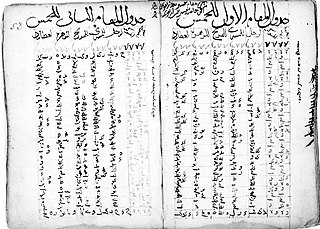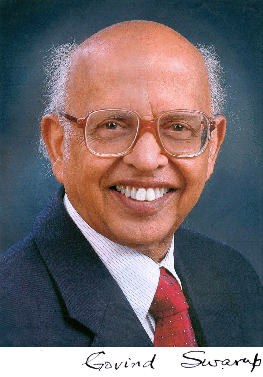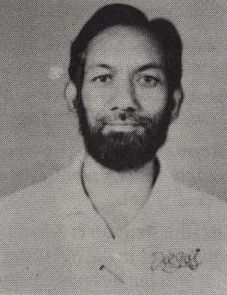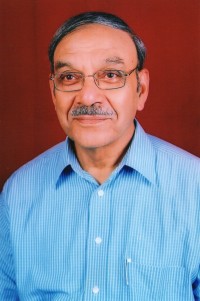
The International Astronomical Union is a non-governmental organisation with the objective of advancing astronomy in all aspects, including promoting astronomical research, outreach, education, and development through global cooperation. It was founded in 1919 and is based in Paris, France.

Jamia Millia Islamia is a premier central university located in New Delhi, India. Originally established at Aligarh, United Provinces during the British Empire in 1920, it moved to its current location in Okhla in 1935. It was given the deemed status by University Grants Commission in 1962. On 26 December 1988, it became a central university.
Munishvara or Munīśvara Viśvarūpa was an Indian mathematician who wrote several commentaries including one on astronomy, the Siddhanta Sarvabhauma (1646), which included descriptions of astronomical instruments such as the pratoda yantra. Another commentary he wrote was the Lilavativivruti. Very little is known about him other than that he came from a family of astronomers including his father Ranganatha who wrote a commentary called the Gụ̄hārthaprakaśa/Gūḍhārthaprakāśikā, a commentary on the Suryasiddhanta. His grandfather Ballala had his origins in Dadhigrama in Vidharba and had moved to Benares. Ballala had several sons who wrote commentaries on astronomy and mathematics. Munisvara's Siddhantasarvabhauma had the patronage of Shah Jahan like his paternal uncle Krishna Daivagna did. He was opposed to fellow mathematician Kamalakara, whose brother also wrote a critique of Munisvara's bhangi-vibhangi method for planetary motions. He was also opposed to the adoption of some mathematical ideas in spherical trigonometry from Arab scholars. An edition of his Siddhanta Sarvabhauma was published in the Princess of Wales Sarasvati Bhavana Granthamala series edited by Gopinath Kaviraj. Munisvara's book had twelve chapters in two parts. The second part had notes on astronomical instruments. He was a follower of Bhaskara II.

Venkataraman Radhakrishnan was an Indian space scientist and member of the Royal Swedish Academy of Sciences. He retired from his career as professor emeritus of the Raman Research Institute in Bangalore, India, of which he had previously been director from 1972 to 1994 and which is named after his father. He served on various committees in various capacities including as the vice president of the International Astronomical Union during 1988–1994. He was also a Foreign Fellow of both the Royal Swedish Academy of Sciences and the U.S. National Academy of Sciences. He was an Associate of the Royal Astronomical Society and a Fellow of the Indian Academy of Sciences, Bangalore.

Indian astronomy refers to astronomy practiced in the Indian subcontinent. It has a long history stretching from pre-historic to modern times. Some of the earliest roots of Indian astronomy can be dated to the period of Indus Valley civilisation or earlier. Astronomy later developed as a discipline of Vedanga, or one of the "auxiliary disciplines" associated with the study of the Vedas dating 1500 BCE or older. The oldest known text is the Vedanga Jyotisha, dated to 1400–1200 BCE.
Vytautas Straižys was a Lithuanian astronomer. In 1963–65 he and his collaborators created and developed the Vilnius photometric system, a seven-color intermediate band system, optimized for photometric stellar classification. In 1996 he was elected a Corresponding Member of the Lithuanian Academy of Sciences. Straižys was an editor of the journal Baltic Astronomy. He spent a lot of time working at the Molėtai Astronomical Observatory. Asteroid 68730 Straizys in 2002 was named after him.

Thanu Padmanabhan was an Indian theoretical physicist and cosmologist whose research spanned a wide variety of topics in gravitation, structure formation in the universe and quantum gravity. He published nearly 300 papers and reviews in international journals and ten books in these areas. He made several contributions related to the analysis and modelling of dark energy in the universe and the interpretation of gravity as an emergent phenomenon. He was a Distinguished Professor at the Inter-University Centre for Astronomy and Astrophysics (IUCAA) at Pune, India.

Piara Singh Gill was an Indian nuclear physicist and a pioneer in cosmic ray nuclear physics. He was the first Director of Central Scientific Instruments Organisation (CSIO) of India. He was research fellow of University of Chicago (1940). He was research Professorship fellow of Tata Institute of Fundamental Research (TIFR) (1947), Officer-on-Special Duty (OSD) with the Atomic Energy Commission in New Delhi. Professor and head of the Department of Physics at Aligarh University (1949), Director of Central Scientific Instruments Organization (CSIO) (1959) and Professor Emeritus at Punjab Agricultural University (1971).

A zij is an Islamic astronomical book that tabulates parameters used for astronomical calculations of the positions of the sun, moon, stars, and planets.

DDU Gorakhpur University is located in Gorakhpur, Uttar Pradesh. The University of Gorakhpur is a teaching and residential-cum-affiliating University. It has entered the league of top five state universities of the country by achieving NAAC Grade A++ rank. It has become the first university of the state to get a 3.78 score. It is about two kilometres (1.2 mi). from the downtown to the east and almost walking distance from railway station to the south.

Mohammad Hamid Ansari is an Indian politician and retired Indian Foreign Service (IFS) officer who was the 12th vice president of India from 2007 to 2017.
Muhammad Abdul Haq Ansari was an Islamic scholar from India. He was the Amir (president) of Jamaat-e-Islami Hind (JIH) from 2003 to 2007. He was the member of Central Advisory Council of Jamaat-e-Islami Hind. He was also the Chancellor of Al Jamia Al Islamia, Shantapuram, Kerala. His book Sufism and Shariah is a synthesis of Sufi and Shariah thought, especially a Tatbiq of Shaikh Ahmed Sir Hindi and Shah Waliullah's thought. It grew out of his in-depth engagement with kalam, tasawwuf and fiqh in Islamic history. His other major contributions are a book on Mishkawah's philosophy and an English translation of Ibn Taymiyyah's fatwas with an introduction. He also wrote 'Learning the Language of Quran' it is one of the best English guides for the beginners learning to read the Qur'an. In New Delhi he established the Islami Academy, aimed at training graduates from secular educational background in Islamic Sciences based on the madrasa curriculum.

Govind Swarup was a pioneer in radio astronomy. In addition to research contributions in multiple areas of astronomy and astrophysics, he was a driving force behind the building of "ingenious, innovative and powerful observational facilities for front-line research in radio astronomy".

Ibn Sina Academy of Medieval Medicine and Sciences (IAMMS) is a trust registered under the Indian Trusts Act, 1882. Mohammad Hamid Ansari, former vice-chancellor of Aligarh Muslim University, Aligarh, formally inaugurated it on 21 April 2001. Department of AYUSH, Ministry of Health and Family Welfare, Government of India gave accreditation to the academy in 2004 and promoted it as 'centre of excellence' in 2008. Membership of the academy is open to anyone who has an interest in the academy's activities particularly on history of medicine and history of science. Being a charitable organization, donations to the Academy are also exempted from Income Tax under section 80G of the Income Tax Act 1961.
Vinod Krishan, is an Indian physicist, a Senior Professor and dean of sciences at the Indian Institute of Astrophysics, Bangalore. She is involved in teaching and research in Plasma Physics. She is a Fellow of the National Academy of Sciences, India and the 1991 recipient of the Vikram Sarabhai Award for Space Sciences.
Shashikumar Madhusudan Chitre FNA, FASc, FNASc, FRAS was an Indian mathematician and astrophysicist, known for his research in Astronomy and Astrophysics. The Government of India honored him, in 2012, with Padma Bhushan, the third highest civilian award, for his services to the sciences.

Vijay Kumar Kapahi was an Indian astrophysicist and the director of the National Centre for Radio Astrophysics, an autonomous division of Tata Institute of Fundamental Research. Known for his research on radio galaxies, quasars and observational cosmology, Kapahi was an elected fellow of all the three major Indian science academies – Indian Academy of Sciences, Indian National Science Academy and National Academy of Sciences, India – as well as of the Maharashtra Academy of Sciences. The Council of Scientific and Industrial Research, the apex agency of the Government of India for scientific research, awarded him the Shanti Swarup Bhatnagar Prize for Science and Technology for his contributions to physical sciences in 1987.
Varun Bhisham Sahni is an Indian theoretical physicist, astrophysicist and a Distinguished Professor at the Inter-University Centre for Astronomy and Astrophysics. Known for his research on cosmology, Sahni is an elected fellow of all the three major Indian science academies viz. Indian Academy of Sciences, Indian National Science Academy and National Academy of Sciences, India. The Council of Scientific and Industrial Research, the apex agency of the Government of India for scientific research, awarded him the Shanti Swarup Bhatnagar Prize for Science and Technology, one of the highest Indian science awards, for his contributions to physical sciences in 2000.
Yashwant Gupta is an Indian astrophysicist and a professor at the National Centre for Radio Astrophysics (NCRA) of the Tata Institute of Fundamental Research. He is currently a Distinguished Professor and also the Centre Director at NCRA.

Ajit Kembhavi is an Indian astrophysicist. He is presently a Professor Emeritus at the Inter-University Centre for Astronomy and Astrophysics, (IUCAA) at Pune, India, of which he was also a founder member. He also serves as a Vice President of the International Astronomical Union. He is the Principal Investigator of Pune Knowledge Cluster along with Professor L. S. Shashidhara.














